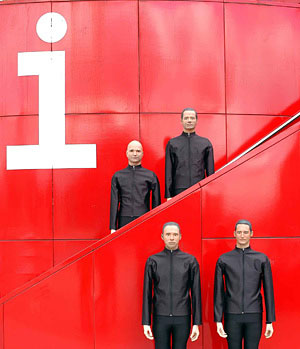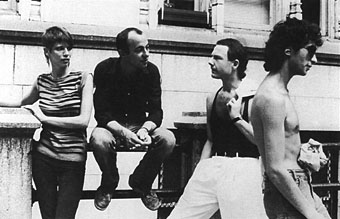Category: {music}
Music
The genius of Kraftwerk
The art of Karl Friedrich Schinkel, 1781–1841

Cathedral Towering over a Town (1813).
Karl Friedrich Schinkel was a German painter and Neo-Classical architect. These paintings, produced early in his career, strongly resemble those of his contemporary Caspar David Friedrich, using landscape as a metaphor and with a similar attention to the quality of natural light. Apparently Schinkel thought too much of the resemblance; after seeing Friedrich’s Monk by the Sea he decided he could never equal Friedrich’s mastery and so concentrated solely on architecture. The picture below of the Queen of the Night is a design for Mozart’s The Magic Flute. Mercury Rev used the painting on the cover of their Secret for a Song single.

Morning (1813).

Medieval City on a River (1815).
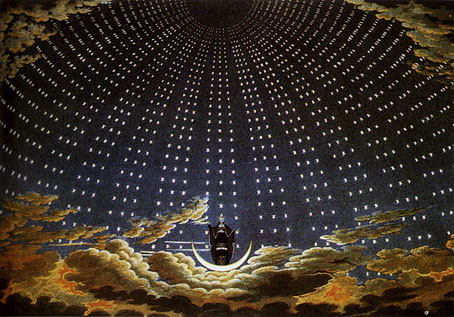
The Queen of the Night (1816).

The Banks of the Spree near Stralau (1817).
Robert Fripp and the League of Gentlemen
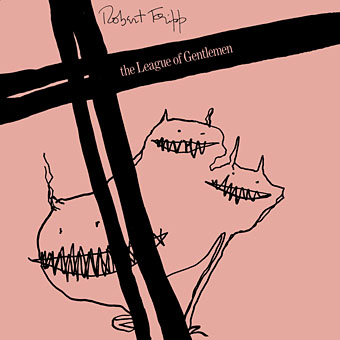
An album released on EG Records (in the UK) in 1981.
Still unavailable in its original form on CD.
The League of Gentlemen began rehearsing on March 19th in a 14th century lodge just outside Wimborne.
The personnel were:
Barry Andrews: organ
Robert Fripp: guitar
Sara Lee: bass guitar
Johnny Toobad: drums.
Our first commitment to work together covered the period March 19th to July 22nd, the second September 8th to September 24th and the third November 10th to December 4th. Johnny Toobad left on November 22nd and Kevin Wilkinson replaced him. On this album KW plays on all but Heptaparaparshinokh and Dislocated. The team played 77 gigs.
Side I
INDISCREET I
INDUCTIVE RESONANCE
MINOR MAN
HEPTAPARAPARSHINOKH
DISLOCATED
PARETO OPTIMUM I
EYE NEEDLES
INDISCREET IISide II
PARETO OPTIMUM II
COGNITIVE DISSONANCE
HG WELLS
TRAP
OCHRE
INDISCREET IIIStudio: Amy’s Shack, Parkstone, Dorset
Engineer: Tony Arnold
Photo of the League taken at Gramercy Park,
New York, during July 1980 by Marjori.
Front cover by Danielle Dax.
Cover glue Rob O’Connor.
Hamsprachtmuzic on “Minor Man” by Danielle Dax,
courtesy of the Lemon Kittens.
Extracts from the Sherborne House talks by
J.G. Bennett courtesy of Elizabeth Bennett,
available from Claymont Communications,
P0 Box 112, Charlestown, West Virginia 25414
Strategic Interaction: Paddy Spinks
Indiscretions compiled by Robert Fripp
Produced by Robert Fripp
Strange Things Are Happening, 1988–1990
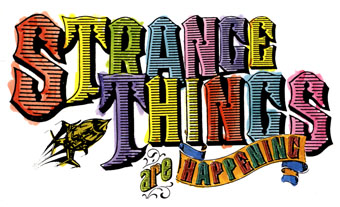
A NOTICE TO OUR PUBLIC…………
It’s now a shade over twenty years since Rolling Stone was launched, complete with a brave new broadside on its interests and purposes.So we too now announce our aims and prejudices and strive to clear a path laying bare our hopes and inspirations. Strange Things will deal from the heart and feature items that we would wish to find on offer. Music, from whatever era, will always be the core, with in-depth studies of a sound or an individual, or a laugh and a picture whenever the situation arises. There will be discographies, reviews, rare photographs; there will be threads or themes across several issues or even, instead, a one off appreciation.
That aside, there will be literature, film and television; cult curiosities or mainstream geniuses. In short, the boundaries are limitless. Over the next few issues the tale of Greenwich Village will unfold; so too the life and work of Richard Brautigan. Frantic new pop will sit beside English folk-rock, the Silver Surfer will meet the San Franciscan scene and white Chicago Blues will rock with Thunderbirds. “Whatever Fits” is our new motto – we’re there wherever strange things are happening.


